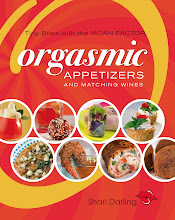
Garlic is a staple in my kitchen. The way in which one cooks with garlic will determine the best wine accompaniment for the resulting dish. While many varieties exist, soft-necked white skinned garlic is the most popular, readily available in supermarkets.
The kind of taster you are obviously determines the amount of garlic  you enjoy in any given dish. Supertasters (with many taste buds) can survive with a clove or two in an entree or sauce, whereas a non taster (with fewer taste buds) demands the entire bulb.
you enjoy in any given dish. Supertasters (with many taste buds) can survive with a clove or two in an entree or sauce, whereas a non taster (with fewer taste buds) demands the entire bulb.
 you enjoy in any given dish. Supertasters (with many taste buds) can survive with a clove or two in an entree or sauce, whereas a non taster (with fewer taste buds) demands the entire bulb.
you enjoy in any given dish. Supertasters (with many taste buds) can survive with a clove or two in an entree or sauce, whereas a non taster (with fewer taste buds) demands the entire bulb. I'm a non taster and so use heavy garlic when cooking for myself. So, I must take the dominant taste of garlic and its cooking method into consideration when choosing an appropriate accompanying wine for the finished dish.
The way in which you cook garlic will determine its most suitable wine partner.
Chopped and sliced garlic do not dissolve in hot oil. As a resul t the chunks or slices leave a mild bitter sensation in the aftertaste of the dish. The best wine matches are ones with well-balanced flavours. You don’t want any one taste sensation predominating in the wine, such as sourness, sweetness or bitterness. White wines such as pinot blanc and unoaked chardonnay and reds like merlot are good partners. Wines produced from these grape varieties generally have no overbearing sensations and therefore support without overpowering the subtle flavour of garlic.
t the chunks or slices leave a mild bitter sensation in the aftertaste of the dish. The best wine matches are ones with well-balanced flavours. You don’t want any one taste sensation predominating in the wine, such as sourness, sweetness or bitterness. White wines such as pinot blanc and unoaked chardonnay and reds like merlot are good partners. Wines produced from these grape varieties generally have no overbearing sensations and therefore support without overpowering the subtle flavour of garlic.
Pressed and crushed garlic dissolves in heat during the cooking process and adds slightly more aromatics and bitterness. This level of garlic calls for a wine with more bitterness to match. White and red wines that undergo oak aging have soft, pleasant bitterness and so are great partners. Look for oak aged chardonnay and merlot from both cold and warm climates, such as Ontario, Oregon, California, Chile, Australia and South Africa.
Browned garlic adds nutty notes to a dish. Orvieto is a lesser-known Italian white grape variety grown in Umbria, central Italy. Its wines are clean and crisp with nutty tones that complement garlic prepared in this fashion.
Garlic grilled over hot coals adds more earthy, toasty and smoky tones. Many countries around the world, such as Australia, Chile and France produce barrel fermented and barrel aged chardonnay with earthy, toasty and smoky tones that harmonize with dishes celebrating grilled garlic. Australia’s semillon can also show toasty, smoky and nutty flavours, along with its deep, rich pineapple and honey notes. This earthy character can also be found in some aged reds. Rioja reserva is a Spanish red wine renowned for undergoing aging in cask and bottle before release. Rioja is known for its spicy, earthy character.
Raw garlic offers the strongest flavour, adding forward bitterness and a zesty bite to dishes. Dishes highlighting raw garlic demand whites and reds with similar bitterness. White wines, such as sauvignon blanc can offer a pleasant bitterness on the finish, complementing the flavour of raw garlic. Cabernet franc and cabernet sauvignon are reds with lots of astringency and tannin that also bring bitterness and dryness to the palate. These characteristics work nicely with raw garlic, as well.
Slow roasted garlic becomes caramelized and sweet. This sweetness requires a white or red wine with a hint of sweetness to match. An off dry riesling, off dry gewürztraminer or off dry rose works well with an oil based pasta highlighting caramelized, slow roasted garlic.
 t the chunks or slices leave a mild bitter sensation in the aftertaste of the dish. The best wine matches are ones with well-balanced flavours. You don’t want any one taste sensation predominating in the wine, such as sourness, sweetness or bitterness. White wines such as pinot blanc and unoaked chardonnay and reds like merlot are good partners. Wines produced from these grape varieties generally have no overbearing sensations and therefore support without overpowering the subtle flavour of garlic.
t the chunks or slices leave a mild bitter sensation in the aftertaste of the dish. The best wine matches are ones with well-balanced flavours. You don’t want any one taste sensation predominating in the wine, such as sourness, sweetness or bitterness. White wines such as pinot blanc and unoaked chardonnay and reds like merlot are good partners. Wines produced from these grape varieties generally have no overbearing sensations and therefore support without overpowering the subtle flavour of garlic.Pressed and crushed garlic dissolves in heat during the cooking process and adds slightly more aromatics and bitterness. This level of garlic calls for a wine with more bitterness to match. White and red wines that undergo oak aging have soft, pleasant bitterness and so are great partners. Look for oak aged chardonnay and merlot from both cold and warm climates, such as Ontario, Oregon, California, Chile, Australia and South Africa.
Browned garlic adds nutty notes to a dish. Orvieto is a lesser-known Italian white grape variety grown in Umbria, central Italy. Its wines are clean and crisp with nutty tones that complement garlic prepared in this fashion.
Garlic grilled over hot coals adds more earthy, toasty and smoky tones. Many countries around the world, such as Australia, Chile and France produce barrel fermented and barrel aged chardonnay with earthy, toasty and smoky tones that harmonize with dishes celebrating grilled garlic. Australia’s semillon can also show toasty, smoky and nutty flavours, along with its deep, rich pineapple and honey notes. This earthy character can also be found in some aged reds. Rioja reserva is a Spanish red wine renowned for undergoing aging in cask and bottle before release. Rioja is known for its spicy, earthy character.
Raw garlic offers the strongest flavour, adding forward bitterness and a zesty bite to dishes. Dishes highlighting raw garlic demand whites and reds with similar bitterness. White wines, such as sauvignon blanc can offer a pleasant bitterness on the finish, complementing the flavour of raw garlic. Cabernet franc and cabernet sauvignon are reds with lots of astringency and tannin that also bring bitterness and dryness to the palate. These characteristics work nicely with raw garlic, as well.
Slow roasted garlic becomes caramelized and sweet. This sweetness requires a white or red wine with a hint of sweetness to match. An off dry riesling, off dry gewürztraminer or off dry rose works well with an oil based pasta highlighting caramelized, slow roasted garlic.
So consider how you are preparing the garlic in your dish before choosing the appropriate wine partner.





No comments:
Post a Comment